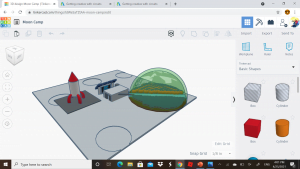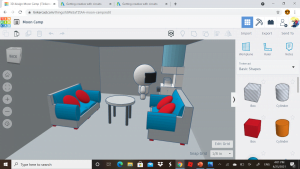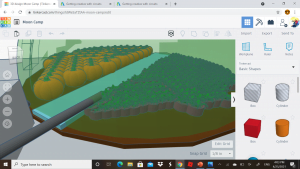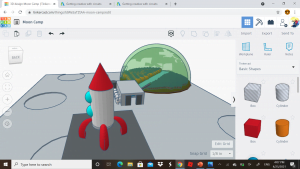Registrations are closed
In the future, to enable astronauts to stay on the Moon for long periods of time, new infrastructures must be developed to overcome important challenges. Such challenges include protection from radiation and meteorites, energy production, the extraction and recycling of water, food production and much more. The Moon Camp Challenge invites students to explore the Moon and decode some of the complexities future astronauts may face.
In Moon Camp Discovery each team’s mission is to 3D design only one component of a Moon Camp using Tinkercad. Teams can choose to design a:
– Lunar lander
– Moon Base
– Lunar rover
– Rocket
– Lunar Orbital Space Station
The design should be adapted to the Moon environment and if possible consider the use of local resources, provide protection and/or living and working facilities for the astronauts.
Moon Camp Discovery is a non-competitive mission for beginners. All teams that submit an entry that complies with the guidelines will receive a participation certificate and their project will be shared on the Moon Camp online platform.
Who can participate?
Participation is open worldwide to students aged up to 19 years old. Moon Camp Discovery is recommended for students aged 6 to 14 years old. Participating students must be supported by a teacher, educator or parent.
Discovery Projects Gallery 2020-2021
Below you can find some of the Moon Camp Discovery projects. For more projects visit the Moon Camp Discovery project gallery.
Team: Fajr Academy
Karachi Pakistan Category: Moon base
External link for Tinkercad 3D design
This is a mooncamp base for astronauts to live with more ease on the moon. The picture with the astronaut is the interior of the structure which is behind the solar panels. It includes a water cooler, two sofas, a table, an astronaut and two glasses half filled with water. Outside of that structure is a greenhouse where there are plants for oxygen and pumpkins for food, there is also a small river of water for drinking and doing whatever is needed with water. Next there is a screen behind the solar panels that is used for the countdown of the rocket. Behind that are the robots which are connected to their chargers at their charging stations. Those robots help in doing the work that needs to be done, for e.g: Collect the food, serve water, e.t.c. Under the rocket is it’s launchpad which safely allows the rocket to blast off without burning anything else nearby. Finally, there are pipes that connect the water cooler with the water container for water, the robot chargers and charging stations with the solar panels for power and the greenhouse with the living structure for oxygen.



















